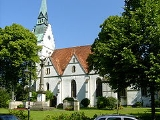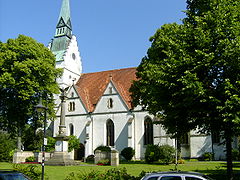
Versmold
Encyclopedia
Versmold is a town in Gütersloh District
in the German
state of North Rhine-Westphalia
. It is located some 30 km west of Bielefeld
.
, Versmold formed the western most town of the historical county of Ravensberg with its capital Bielefeld
. Since 1614 the county belonged to Brandenburg
and later to Prussia
. Within the predominant Catholic Westphalia, the county of Ravensberg is Protestant. In 1719 the King of Prussia granted city rights in order to raise more taxes.
In the 19th century the county was poor and subsistence oriented. Only the linen production is worthy to note. During the harvest season many people sought for an additional income in Holland. During the 1850s and 1860s the city saw an extensive emigration to America, because of the weak economic situation. Many of them settled in the Midwest, especially Missouri and Texas.
After 1871 when the newly united Germany
built up a navy, the linen-industry became prosperous by providing sailing canvases. Most notably engaged in the linen-industry was the family Delius. In the 1820s some members of the family emigrated to Mexico
where they established a flourishing import-export business. By the late 19th century they had representations in Berlin and Hamburg.
Since World War II the city flourished mainly due to its meat-processing factories, which had grown out of the rural art of sausage-making. The bigger companies and factories took even the specialties of small often one-man workshops into their sales program. This created the profession of the Kleinfleischhaendler (small scale meat dealer) which became typical for the region. This regional peculiarity faded out during the 1980s and 1990s. Supply industries evolved around the meat processing factories. Several forwarding companies specialized in food transportation. The largest of them, Kraftverkehr Nagel operates today in many countries. Its head quarter remains in Versmold.
The industry diversified after World War II. In the late 1940s a local entrepreneur Gustav Baumhoefer founded a shoe factory producing under the brand name Ravensberger Schuhe. The factory closed in the early 1980s because of shifts in world markets for shoes. The firm was not competitive anymore. In the 1950s a wood processing factory producing frames was opened, the Wirus Werke, also shut down during the 1980s. The mother company resides still in Guetersloh. A major factory for bottle crown caps Bruenninghaus is flourishing.
Today Versmold's population numbers around 20,000.
A bronze medallion of Otto von Bismarck
and bronze bust of the German emperor Wilhelm I are signs of the patriotism and the Bismarck-cult in the 1880s. They are in the city's park. The bust of Wilhelm I is since more than 20 years much damaged by vandalism and hard to find hidden behind bushes. The medallion however is attached to a stone block leisurely placed at one of the walkways.
The fallen World War I soldiers from the municipality of Versmold are remembered on a monument in front of the Protestant church, a column crowned by an eagle (see picture). The victims of World War II, without giving their names, found in the sixties a place of commemoration in a small park behind the town hall in the form of bronze crosses and a bronze flambeaux. In the late 1990s, a memorial for the former Jewish population was set up in the middle of the town, very prominently, right in front of the town hall. It lists the names of the local victims of the Holocaust. Most prominent among them figures the family Spiegel
.
The new blossoming of the town after World War II is visualized by a bronze statue of a worker with a pig passing under his right leg. He holds in both hands a stick with six sausages dangling from it. It stands across the Protestant church on a modern (1980s) Italian style 'piazza'. This statue is locally known as "Schweinebrunnen" (pig's fountain)".

Gütersloh (district)
Gütersloh is a Kreis in the north-east of North Rhine-Westphalia, Germany. Neighboring districts are Osnabrück, Herford, district-free Bielefeld, Lippe, Paderborn, Soest and Warendorf.-History:...
in the German
Germany
Germany , officially the Federal Republic of Germany , is a federal parliamentary republic in Europe. The country consists of 16 states while the capital and largest city is Berlin. Germany covers an area of 357,021 km2 and has a largely temperate seasonal climate...
state of North Rhine-Westphalia
North Rhine-Westphalia
North Rhine-Westphalia is the most populous state of Germany, with four of the country's ten largest cities. The state was formed in 1946 as a merger of the northern Rhineland and Westphalia, both formerly part of Prussia. Its capital is Düsseldorf. The state is currently run by a coalition of the...
. It is located some 30 km west of Bielefeld
Bielefeld
Bielefeld is an independent city in the Ostwestfalen-Lippe Region in the north-east of North Rhine-Westphalia, Germany. With a population of 323,000, it is also the most populous city in the Regierungsbezirk Detmold...
.
History
Belonging to WestphaliaWestphalia
Westphalia is a region in Germany, centred on the cities of Arnsberg, Bielefeld, Dortmund, Minden and Münster.Westphalia is roughly the region between the rivers Rhine and Weser, located north and south of the Ruhr River. No exact definition of borders can be given, because the name "Westphalia"...
, Versmold formed the western most town of the historical county of Ravensberg with its capital Bielefeld
Bielefeld
Bielefeld is an independent city in the Ostwestfalen-Lippe Region in the north-east of North Rhine-Westphalia, Germany. With a population of 323,000, it is also the most populous city in the Regierungsbezirk Detmold...
. Since 1614 the county belonged to Brandenburg
Brandenburg
Brandenburg is one of the sixteen federal-states of Germany. It lies in the east of the country and is one of the new federal states that were re-created in 1990 upon the reunification of the former West Germany and East Germany. The capital is Potsdam...
and later to Prussia
Prussia
Prussia was a German kingdom and historic state originating out of the Duchy of Prussia and the Margraviate of Brandenburg. For centuries, the House of Hohenzollern ruled Prussia, successfully expanding its size by way of an unusually well-organized and effective army. Prussia shaped the history...
. Within the predominant Catholic Westphalia, the county of Ravensberg is Protestant. In 1719 the King of Prussia granted city rights in order to raise more taxes.
In the 19th century the county was poor and subsistence oriented. Only the linen production is worthy to note. During the harvest season many people sought for an additional income in Holland. During the 1850s and 1860s the city saw an extensive emigration to America, because of the weak economic situation. Many of them settled in the Midwest, especially Missouri and Texas.
After 1871 when the newly united Germany
Germany
Germany , officially the Federal Republic of Germany , is a federal parliamentary republic in Europe. The country consists of 16 states while the capital and largest city is Berlin. Germany covers an area of 357,021 km2 and has a largely temperate seasonal climate...
built up a navy, the linen-industry became prosperous by providing sailing canvases. Most notably engaged in the linen-industry was the family Delius. In the 1820s some members of the family emigrated to Mexico
Mexico
The United Mexican States , commonly known as Mexico , is a federal constitutional republic in North America. It is bordered on the north by the United States; on the south and west by the Pacific Ocean; on the southeast by Guatemala, Belize, and the Caribbean Sea; and on the east by the Gulf of...
where they established a flourishing import-export business. By the late 19th century they had representations in Berlin and Hamburg.
Since World War II the city flourished mainly due to its meat-processing factories, which had grown out of the rural art of sausage-making. The bigger companies and factories took even the specialties of small often one-man workshops into their sales program. This created the profession of the Kleinfleischhaendler (small scale meat dealer) which became typical for the region. This regional peculiarity faded out during the 1980s and 1990s. Supply industries evolved around the meat processing factories. Several forwarding companies specialized in food transportation. The largest of them, Kraftverkehr Nagel operates today in many countries. Its head quarter remains in Versmold.
The industry diversified after World War II. In the late 1940s a local entrepreneur Gustav Baumhoefer founded a shoe factory producing under the brand name Ravensberger Schuhe. The factory closed in the early 1980s because of shifts in world markets for shoes. The firm was not competitive anymore. In the 1950s a wood processing factory producing frames was opened, the Wirus Werke, also shut down during the 1980s. The mother company resides still in Guetersloh. A major factory for bottle crown caps Bruenninghaus is flourishing.
Today Versmold's population numbers around 20,000.
Memorials
As in many small German towns part of its modern history had become a visible expression within the cityscape. A small unimposing stone cross from the 11th c. in the middle of a traffic circle had been once the sign for a rural medieval court.A bronze medallion of Otto von Bismarck
Otto von Bismarck
Otto Eduard Leopold, Prince of Bismarck, Duke of Lauenburg , simply known as Otto von Bismarck, was a Prussian-German statesman whose actions unified Germany, made it a major player in world affairs, and created a balance of power that kept Europe at peace after 1871.As Minister President of...
and bronze bust of the German emperor Wilhelm I are signs of the patriotism and the Bismarck-cult in the 1880s. They are in the city's park. The bust of Wilhelm I is since more than 20 years much damaged by vandalism and hard to find hidden behind bushes. The medallion however is attached to a stone block leisurely placed at one of the walkways.
The fallen World War I soldiers from the municipality of Versmold are remembered on a monument in front of the Protestant church, a column crowned by an eagle (see picture). The victims of World War II, without giving their names, found in the sixties a place of commemoration in a small park behind the town hall in the form of bronze crosses and a bronze flambeaux. In the late 1990s, a memorial for the former Jewish population was set up in the middle of the town, very prominently, right in front of the town hall. It lists the names of the local victims of the Holocaust. Most prominent among them figures the family Spiegel
Paul Spiegel
Paul Spiegel was leader of the Zentralrat der Juden in Germany and the main spokesman of the German Jews...
.
The new blossoming of the town after World War II is visualized by a bronze statue of a worker with a pig passing under his right leg. He holds in both hands a stick with six sausages dangling from it. It stands across the Protestant church on a modern (1980s) Italian style 'piazza'. This statue is locally known as "Schweinebrunnen" (pig's fountain)".

Communities forming the town
- Versmold
- Bockhorst
- Hesselteich
- Loxten
- Oesterweg
- Peckeloh
Local Newspapers
- Haller Kreisblatt (with a daily page on local events). Oldest traditional newspaper for the western part of the county of Ravensberg.
- Westfalenblatt, with a daily local page Versmolder Anzeiger
Literature
- Vinke, Wilhelm, Heimatgeschichte der Stadt Versmold und Umgebung, Self-published, 1924
- Vinke, Wilhelm, Versmold - Ein Volks- und Heimatbuch, Amtsverwaltung, 1962
- Vinke, Wilhelm, 250 Jahre Stadt Versmold 1719-1969, Stadt Versmold, 1969
- Westheider, Rolf, Versmold - Eine Stadt auf dem Weg ins 20.Jahrhundert, Verlag für Regionalgeschichte, 1994; ISBN 3-89534-276-9
- Westheider, Rolf, 900 Jahre kirchliches Leben in Versmold 1096-1996, Verlag für Regionalgeschichte, 1996; ISBN 3-89534-165-7
- Beckmann, Volker, Jüdische Bürger im Amt Versmold - Deutsch-jüdische Geschichte im westlichen Ravensberger Land, Verlag für Regionalgeschichte, 1998; ISBN 3-89534-248-3

